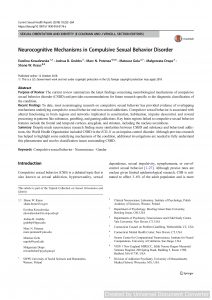Mental Health
Neurocognitive Mechanisms in Compulsive Sexual Behavior Disorder
 Full Article Title: Neurocognitive Mechanisms in Compulsive Sexual Behavior Disorder
Full Article Title: Neurocognitive Mechanisms in Compulsive Sexual Behavior Disorder
Open Access: No
Abstract
Purpose of Review: The current review summarizes the latest findings concerning neurobiological mechanisms of compulsive sexual behavior disorder (CSBD) and provides recommendations for future research specific to the diagnostic classification of the condition.
Recent Findings: To date, most neuroimaging research on compulsive sexual behavior has provided evidence of overlapping mechanisms underlying compulsive sexual behavior and non-sexual addictions. Compulsive sexual behavior is associated with altered functioning in brain regions and networks implicated in sensitization, habituation, impulse dyscontrol, and reward processing in patterns like substance, gambling, and gaming addictions. Key brain regions linked to compulsive sexual behavior features include the frontal and temporal cortices, amygdala, and striatum, including the nucleus accumbens.
Summary: Despite much neuroscience research finding many similarities between CSBD and substance and behavioral addictions, the World Health Organization included CSBD in the ICD-11 as an impulse-control disorder. Although previous research has helped to highlight some underlying mechanisms of the condition, additional investigations are needed to fully understand this phenomenon and resolve classification issues surrounding CSBD.
Citation
Kowalewska, E., Grubbs, J. B., Potenza, M. N., Gola, M., Draps, M., & Kraus, S. W. (2018). Neurocognitive mechanisms in compulsive sexual behavior disorder. Current Sexual Health Reports, 10(4), 255–264. https://doi.org/10.1007/s11930-018-0176-z
